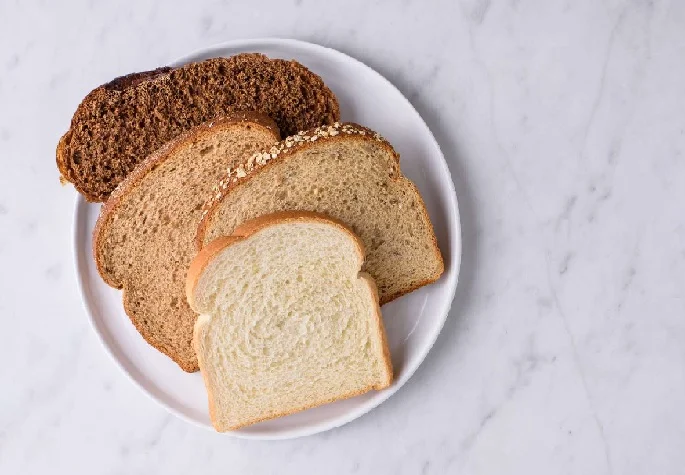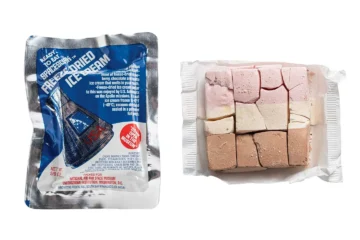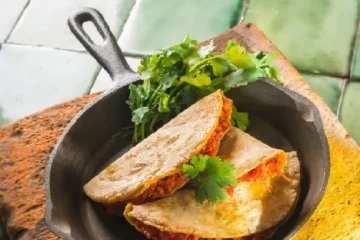Homemade slice of bread is always a classic, but recently, it’s experienced a major revival. Many of us are spending more time at home, seeking comfort in baking our own delicious creations. Bread-making, especially when it comes to crusty artisan loaves, has surged in popularity. However, with this rise in homemade baking comes a new challenge: how to properly slice a fresh, thick-crusted loaf of bread.
If you’ve ever struggled with slicing a freshly baked slice of bread, you’re not alone. This task can be tricky, especially with crusty, oversized loaves. But don’t worry! We’ve gathered advice from professional bakers to guide you through the process. Read on to learn the best techniques, tools, and tips for slicing your bread like a pro.
The Origin of Sliced Bread
Sliced bread didn’t come into existence until 1928 when Otto Frederick Rohwedder, an American inventor, created the first bread slicer. Before this, people bought loaves whole and sliced them at home, which was time-consuming and often resulted in uneven slices. The introduction of pre-sliced bread was revolutionary. It made sandwiches and toasts more accessible, and sales of bread skyrocketed almost overnight. The phrase “the greatest thing since sliced bread” was born, cementing its place in popular culture as a benchmark for innovation.

How a Slice of Bread is Made
Making bread is a science. It starts with basic ingredients: flour, water, yeast, and salt. These simple components combine through the magic of fermentation, causing the dough to rise. Once baked, the bread is sliced either manually or by machine, with most commercial loaves being sliced into even, uniform pieces for convenience. The thickness of the slice can vary depending on its purpose.
Types of Bread and Slices Around the World
Bread is a universal food, but how it’s sliced and served can differ greatly depending on where you are. Here’s a look at how a slice of bread varies across cultures:
- United Kingdom: Bread slices come in various thicknesses such as “Extra Thick,” “Thick,” “Medium,” or “Thin,” with thickness ranging from 10mm to 16mm.
- Ireland: Known as “sliced pan,” bread is often sold in 800g or 400g loaves, with each slice evenly cut for easy use in sandwiches or toast.
- Japan: Bread is typically labeled by the number of slices per loaf, with common options being 4, 6, 8, or even 10 slices.
- United States and Canada: Texas Toast is a popular type of bread that is sliced twice as thick as regular sandwich bread. It’s often used for hearty breakfast dishes like French toast.
- Australia: Bread slices are usually 12-13mm for “sandwich” slices or 18mm for “toast” slices, with thicker “café” slices measuring up to 24mm.
The Convenience of Sliced Bread
The reason sliced bread became so popular was its convenience. You could make sandwiches quickly, toast a slice without any hassle, and have a consistent thickness for every meal. It also allowed bread companies to innovate with packaging, making it easier for customers to store and preserve bread.
The Versatility of a Slice of Bread
A slice of bread is incredibly versatile. It can be toasted, buttered, grilled, or turned into croutons. Here are a few popular ways to make the most of a simple slice of bread:
- Toast: Arguably the most common way to enjoy a slice of bread. Toast it to your desired level of crispness and add butter, jam, or avocado.
- Sandwiches: The base of any great sandwich is a good slice of bread. Whether it’s a BLT or a grilled cheese, the right bread can make all the difference.
- French Toast: Transform a stale slice of bread into a sweet breakfast by dipping it in an egg mixture and frying it to golden perfection.
- Croutons: Dice up a slice of bread, season it, and bake or fry for a crunchy topping for salads or soups.
- Bread Pudding: Old slices can be repurposed into a delicious dessert by soaking them in milk and baking with sugar and spices.
The Idiom: “The Best Thing Since Sliced Bread”
Sliced bread became such an iconic invention that it inspired the phrase, “the best thing since sliced bread.” This idiom is used to describe something innovative or groundbreaking, showing just how significant the invention of pre-sliced bread was at the time.

Thickness Matters: Choosing the Right Slice for the Right Job
The thickness of a slice of bread plays a key role in how it’s used. Here are some general guidelines:
- Thin slices (10-12mm): Perfect for delicate sandwiches where the bread shouldn’t overpower the filling.
- Medium slices (12-15mm): Ideal for everyday use, such as sandwiches or toast.
- Thick slices (16-20mm): Best for hearty sandwiches, Texas toast, or when you want the bread to be the star of the dish.
Choosing the right thickness for the task at hand will enhance the overall texture and flavor of your meal.
Slicing Bread at Home
If you bake your own bread or buy unsliced loaves, slicing them at home can feel daunting. Always use a serrated bread knife, as its saw-like edges will cut through crusts cleanly without squashing the soft interior. Use long, smooth strokes to maintain the bread’s shape, and make sure your cutting board is stable.
How to Store Sliced Bread
One of the advantages of sliced bread is its longevity. To keep your slice of bread fresh, follow these storage tips:
- Store at Room Temperature: Keep your bread in a bread box or a sealed bag at room temperature for 3-5 days.
- Freeze for Long-Term Storage: Sliced bread freezes well. Store slices in a freezer-safe bag, and toast them directly from frozen for convenience.
- Avoid Refrigeration: Storing bread in the fridge can cause it to dry out faster, so it’s best to avoid this unless you’re planning to use it within a day or two.
Bread in Popular Culture
Bread, and specifically sliced bread, has become a symbol of convenience and progress. Its introduction in the 1920s marked a turning point in how people prepared their meals. Today, bread continues to be an important staple in households worldwide. The idiom “the best thing since sliced bread” perfectly captures how this simple invention revolutionized everyday life.
The Future of Sliced Bread
As food trends evolve, so does bread. Artisanal and whole-grain loaves have gained popularity, but the convenience of a slice of bread remains unchanged. Sliced bread will always have its place at the table, whether for a quick toast or a gourmet sandwich.
Why Fresh Homemade Bread is Different
Store-bought bread often comes pre-sliced and soft, making it easy to handle. However, homemade loaves are often denser and have a thicker crust, making them more challenging to slice. When you bake your own bread, you’ll notice that it has more texture and structure, which requires a special approach to cutting.
After enjoying the superior taste of fresh homemade bread, many find pre-packaged loaves pale in comparison. But with that shift comes the challenge of how to get the perfect slice of bread from your homemade masterpiece.
How to Properly Slice Bread: Tips from a Pro Baker
We asked a professional for advice—Cem, co-founder of The Brot Box and a seasoned baker. Here’s what he had to say about slicing bread correctly:
“The key to slicing crusty bread lies in the angle and technique. Start by placing your loaf on a sturdy cutting board. Open your hand, as if giving a high-five, and gently press down on the bread to keep it steady. Then, using a serrated bread knife, cut at a 45-degree angle. Many people make the mistake of starting at the very end of the loaf, where the crust is toughest. This often causes the knife to slip, risking injury.”
By following this approach, you’ll get a cleaner, more even slice of bread, without crushing the loaf or hurting yourself.
Step-by-Step Guide to Slicing Bread
- Choose the Right Knife
A good-quality serrated knife is your best friend when it comes to cutting bread. Its saw-like edge makes it easier to cut through tough crusts without applying too much pressure. - Prepare Your Surface
Place your loaf on a large, stable cutting board. Make sure the board isn’t sliding around to avoid accidents. A no-slip surface is key to safe slicing. - Position the Bread
Large, round loaves can be trickier to slice. If your loaf is too big, consider slicing it in half first for easier handling. - Hand Placement
Place your hand over the crust, gently gripping the loaf by the sides. This stabilizes the bread while you cut and ensures even slices. - Cut at an Angle
Approach the loaf at a slight angle. This makes it easier to break through the crust and maintain a clean, even cut. - Saw Gently
Use a sawing motion as you slice through the bread. A back-and-forth motion is key here—let the knife do the work without applying too much force. This helps preserve the structure of the slice of bread. - Take Your Time
Slicing bread takes practice, especially homemade varieties. Don’t worry if you can’t achieve perfectly thin slices right away—it gets easier with time.
The Importance of Using a Serrated Knife
You might wonder why a serrated knife is so important when cutting through a crusty slice of bread. The answer lies in how this knife works. The serrated edges grip the crust, allowing you to saw through the loaf without pressing down too hard. If you use a standard chef’s knife, you’ll likely crush the bread, leaving you with misshapen or flattened slices. Serrated knives offer the best control and precision when slicing through tough crusts and soft interiors.
How to Prevent Your Bread from Crumbling
One of the most common issues people face when slicing homemade bread is crumbling. To avoid this, it’s important to ensure your loaf is fully cooled before cutting. Cutting into a hot loaf can cause the inside to tear and crumble. Letting your bread cool will give it time to set, resulting in cleaner slices.
Additionally, aim for slices that are about ½ inch thick. Thinner slices tend to fall apart more easily, while thicker slices maintain their shape better.
Preparing Your Bread for Serving
If you’re preparing bread for a meal or gathering, presentation matters. To make serving easier, pre-slice your loaf into manageable pieces. Once you’ve cut each slice of bread, consider serving them on a breadboard with butter or spreads nearby. This allows guests to help themselves and adds an elegant touch to your table.
Brief History of Sliced Bread
Did you know that sliced bread wasn’t always the norm? Before the invention of the bread slicer, people used to cut every slice by hand. The first commercially available pre-sliced bread appeared in 1928, thanks to Otto Frederick Rohwedder, an inventor from Iowa. His bread-slicing machine revolutionized the baking industry, and by 1933, about 80% of bread in the U.S. was pre-sliced.
The introduction of pre-sliced bread changed the way people consumed bread, increasing its popularity and making it a household staple. In fact, it even impacted the consumption of spreads like butter and jam, as more people enjoyed multiple slices at a time.
Conclusion
The phrase “slice of bread” is a common expression that refers to a single portion of bread, typically cut from a loaf. It symbolizes simplicity, essential sustenance, or a basic unit of food. Depending on context, it can be used literally in discussions about meals or metaphorically to represent fundamental needs or components in broader topics.
FAQs: Slice of Bread
Q1: What does “slice of bread” mean?
A: It refers to a single piece of bread cut from a loaf, commonly used in meals like sandwiches, toast, or snacks.
Q2: How thick is a typical slice of bread?
A: The thickness of a slice can vary, but a standard slice is usually about 1 cm (0.4 inches) thick, depending on the bread type and cutting method.
Q3: What are some common uses for a slice of bread?
A: Slices of bread are used to make sandwiches, toast, bread pudding, croutons, and as a base for spreads like butter, jam, or peanut butter.
Q4: Can a slice of bread be frozen for later use?
A: Yes, slices of bread can be frozen to extend their shelf life. Simply place them in an airtight bag or container before freezing.
Q5: What is the nutritional value of a slice of bread?
A: The nutrition varies by bread type. For example:
- White bread: ~70–80 calories per slice
- Whole grain: ~80–100 calories per slice, with more fiber and nutrients.
For getting more information Thezvideo.




